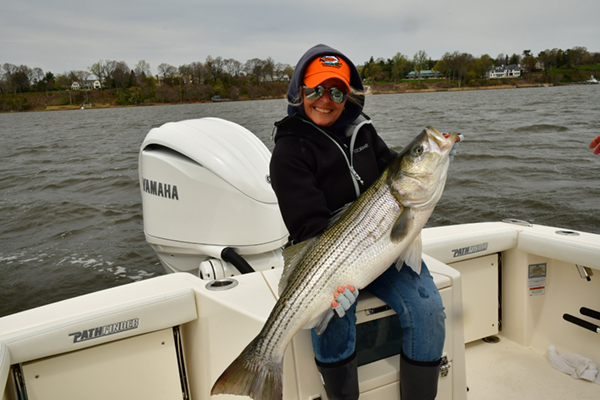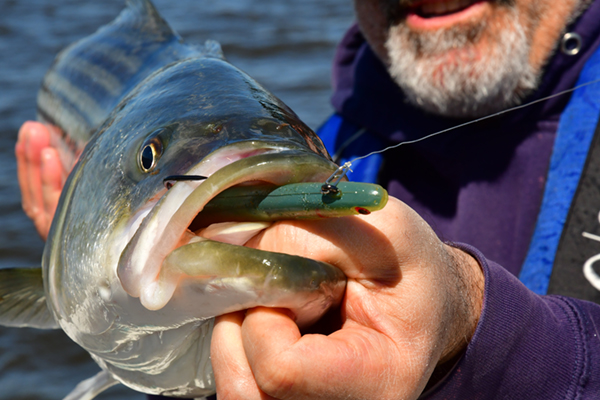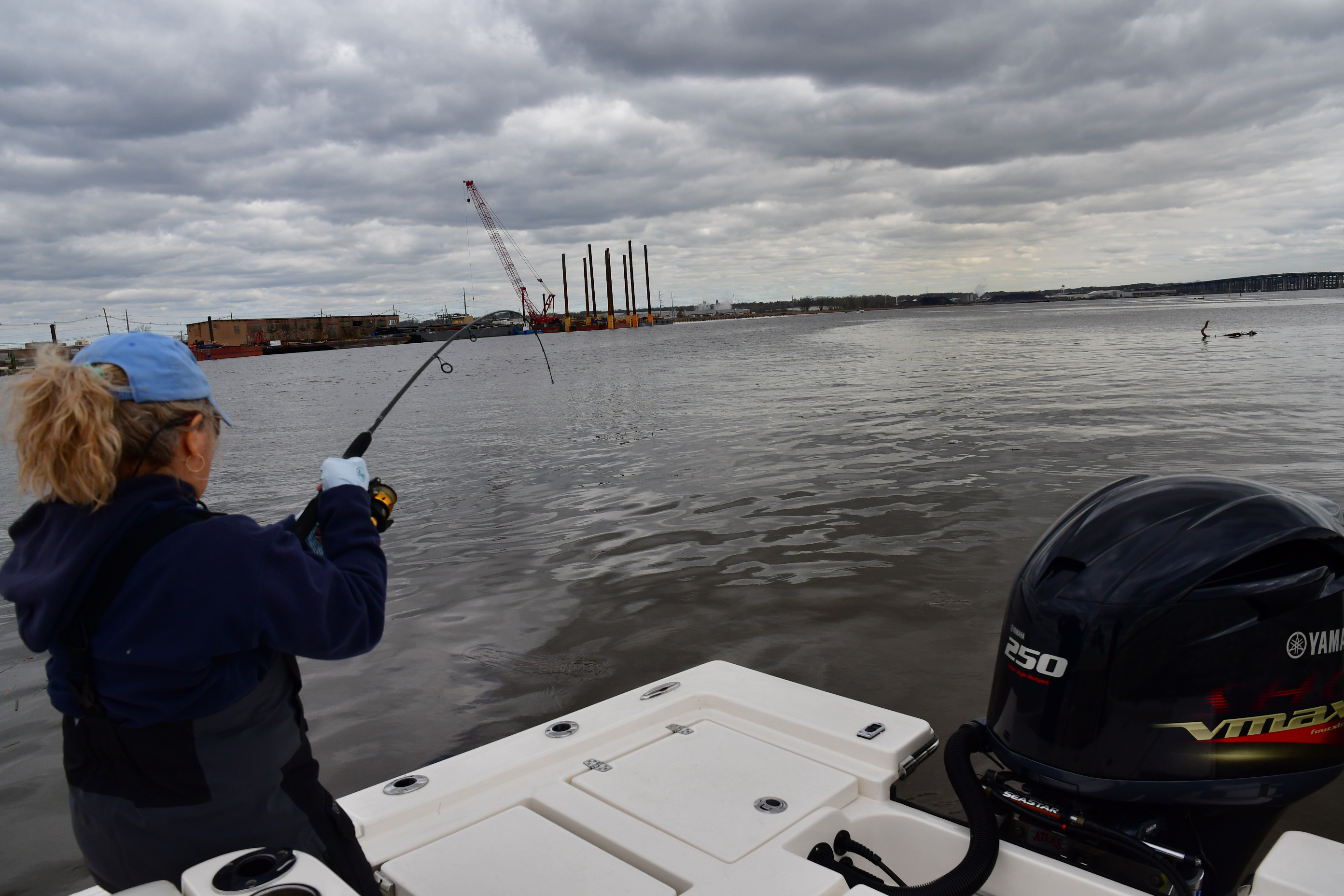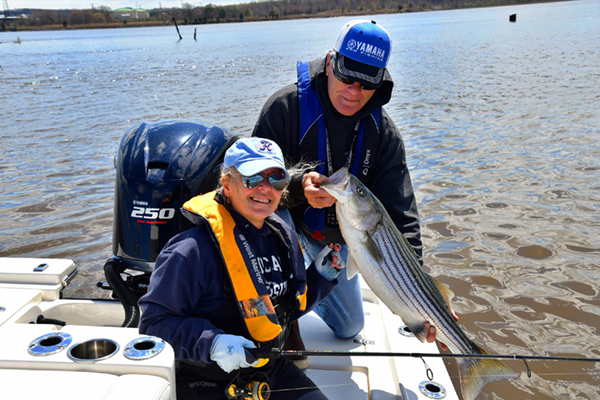Spring is the time striped bass mass in estuaries near the rivers of their birth. Young fish that have not reached spawning age have remained there throughout most of the winter, while the mature fish will be returning from their wintering grounds in preparation for spawning. Spawning takes place far upriver in freshwater. After spawning, these bigger fish head back to saltwater ready for their next migration to their summer feeding grounds off the northeastern United States and Canada.
There are two major spawning areas: the Chesapeake Bay with its numerous tributary rivers, and the Hudson River with its expansive estuaries. Even though the Delaware River hosts a significant spawning aggregation of striped bass, it is not considered a major contributor to the coastwide stocks, but it does offer excellent fishing opportunities for stripers. If you’re lucky enough to live in proximity to any of these areas, spring is the best time of the year to be a striper fisherman.

For the first few years of their lives, striped bass remain in the estuaries that surround the rivers of their birth, and they are on the prowl and available to anglers in early spring. These fish give anglers an opportunity to enjoy some fantastic light tackle fishing for bass that typically range from five to fifteen pounds. As spring progresses, larger bass return to those same estuaries and stage for spawning, and your chances of catching trophy-size bass increase dramatically.
Some of the hottest spring fishing on the entire striper coast is found in the estuaries surrounding the Hudson River extending throughout New York Harbor, Sandy Hook, Raritan Bay, Jamaica Bay and the many small rivers like the Raritan, Navesink and Shrewsbury. The fishing action can start as early as mid-March, but the timing is weather dependent. Excessive rain, cold temperatures and high winds experienced this year have made finding and catching early season fish more difficult than the last couple of years. March and the first half of April have been particularly tough, but things are about to break wide open.
Let’s cover a few of the techniques for spring fishing from early river action to post spawn in open water, but before we get into that, a few words to the wise. Review the regulations pertaining to striped bass where you fish as they have changed in many areas to provide additional protection to the fish of spawning age. The current coastwide slot limit set by the Atlantic States Marine Fisheries Commission in 2023 allows anglers to keep one fish per day between 28 and 31-inches, but different slot sizes are in place for tidal rivers and bays in some states. All fish larger or smaller must be released. Individual states have some latitude to set regulations independently, particularly seasonal closures. A good example are the regs for New York and New Jersey. While contiguous states, the New Jersey striper season opens in tidal waters (rivers and bays) on March 1 but there is no closed season for ocean waters. In New York, the striper season for tidal waters opens April 1 and closes November 30, and the ocean fishery opens April 15 and closes December 15. To fish in saltwater, you need a registration card, which is a free version of a saltwater fishing license. Both New York and New Jersey require this card, but the don’t accept each other’s. So, if you are fishing in the New York Bight from New Jersey and you cross into New York waters, make sure you have a New York registration card with you. Both are free and easily obtained online and you simply print out the required registration certificate.

There are so many ways to fish for striped bass, it can boggle the mind of a newcomer to the fishery. Trolling techniques, chunking with cut bait, bottom fishing with worms or clams, fishing with live menhaden or eels, you can spend a small fortune on the specialized tackle and bait if you try and use them all. But for a lot of striper fishermen, nothing is more satisfying than fooling a striper casting artificial lures. There’s something more gratifying about feeling a striper hit a lure on the retrieve with the rod in your hands. The initial impact and the hookset make the encounter so much more personal than waiting for a bite on a live bait or trolled lure. Once you experience the visual excitement of a bass smacking a surface plug, you’ll wonder if it was you that got hooked rather than the fish.
Let’s look at some of the artificial lures that are most effective during the spring months leading up to spawning. The earliest striper action where artificials come into play usually takes place in tidal rivers as the young fish become active. The timing can vary from year to year, but by mid-March anglers who brave the elements are usually being rewarded with catches of school-size fish. Since the fish are chasing smaller baitfish, small lures get the most attention. Carry a selection of soft plastic baitfish imitations like Tsunami, Storm and NLBN paddle tail shads, and hard baits like swimming plugs by a bunch of different lure companies. Preferred tackle includes a seven-foot spinning rod with a reel loaded with 10 or 15-pound test braid tipped with a three-foot length of fluorocarbon leader.

Use a Tactical Angler clip at the terminal end for quick lure changes because things like size, depth and action can make a difference from day to day. Carry a mix of different colored lures and change them frequently if you are not getting bites. At times, the bass will prefer a lure that runs closer to the surface like a swimming plug, or that holds closer to the bottom like the weighted soft plastic lures. When the water is colder, both bass and baitfish will be moving a little slower and a slow-moving lure will get more attention. As the water warms into the mid-fifties and higher, faster retrieve speeds will garner more aggressive strikes. Rising water temperatures also signal trying topwater lures such as smaller poppers and spook-type lures that slide from side-to-side as you work them with rod action.
Some of the best early season river spots to try are shallow flats and areas along banks. Shallows tend to warm faster and just a couple degrees can make a difference in where bass will be foraging. Pay particular attention to areas that get the most direct sunlight. This is especially true during the high, outgoing tide period as bait and bass will move into shallows with the rising tide and will often feed heavily as the tide falls. Tides play an important role in where stripers will be holding in a river environment and their movements as the tides rise and fall. Pay attention to tide stages as you fish and you will hit on patterns that will repeat over periods of time and even from year to year.
As the spring season moves into mid to late April, large schools of menhaden begin moving into the estuaries and the fishing action can light. Where there are menhaden, striped bass will not be far away, and these will typically be larger fish. The vanguard of stripers returning to the estuary before making the run upriver to spawn will also start to show up and that means your chance of catching trophy-size bass increases. In open bay waters spend some time finding schools of menhaden. They will be on the move with the tides. These are big baitfish so the lures to use are also going to be larger and that requires heavier tackle just to cast them. A 7-1/2 foot medium-heavy action rod with a 4000-series reel loaded with 30-pound test braid and a 50-pound fluorocarbon leader will handle throwing the big lures and fighting larger bass.
Bass will be found tracking schools of bait holding lower in the water column when not actively feeding and there are lures that will get down there in front of them. Larger paddle tail shads up to nine inches in length do a great job of imitating menhaden. The basic colors are white or pearl white and chartreuse. You can cast one, allow to sink and the reel it back on a straight retrieve or bounced it along the bottom in a lift and drop motion. A paddle tail shad variant that has its moments is the casting Mojo, a large 2- or 3-inch ball-shaped lead head with a nylon skirt and 6-inch shad body. It can be fished closer to the bottom in deeper bay water or worked midwater with a faster retrieve. White and chartreuse are the only colors needed with these lures. Another subsurface favorite is the flutter spoon, a large seven-to nine-inch metal lure with a single treble hook that you drop to the bottom, then lifted vertically with the rod tip and allowed to “flutter” back down on an almost slack line. Strikes will most likely come as the spoon is on the fall, although they can also be cast and slowly retrieved. You can fish them in the deepest bay waters and work them at whatever level the fish are showing on your depthfinder.
Metal lipped swimming plugs from 7 to 10-inches in length are great producers. Many are made by local plug makers and sold specifically for striped bass fishermen, and they are designed to run at various levels on retrieve ranging from just below the surface to ten feet. They share a rolling side-to-side action when retrieved slowly. They come in a wide range of colors. Some incorporate thermoplastic bodies and a great many are still made the old-time honored way using wood.
There will be more instances of bass feeding on top as season slides into May and a variety of surface poppers will catch bass when they are busting bait near the surface. Some favorites are the Tactical Angler pencil popper, the Tsunami I-Pop, to mention just a couple. Another variation on surface lures that can be deadly this time of year are locally called Doc plugs because they are a takeoff on a freshwater musky lure called a Musky Doc. They are seven or nine-inch cigar-shaped lures that float when not in motion, and they are worked using the rod tip to make the slide from side-to-side across the surface as you slowly turn the reel handle. They can induce savage strikes when fished around menhaden schools that will definitely get your heart pumping. Plain white, bone or chartreuse are the only colors you need, and the larger ones have consistently outproduced the smaller ones.
.jpg)
With a selection of lures and a couple of rods and reels capable of handling them you can get in on the best striped bass fishing of the year. Just remember to keep your eyes on the water and be aware of any local preferences in lure selection because new lures come along regularly. Good fishing.
Back to Blue Life
There are two major spawning areas: the Chesapeake Bay with its numerous tributary rivers, and the Hudson River with its expansive estuaries. Even though the Delaware River hosts a significant spawning aggregation of striped bass, it is not considered a major contributor to the coastwide stocks, but it does offer excellent fishing opportunities for stripers. If you’re lucky enough to live in proximity to any of these areas, spring is the best time of the year to be a striper fisherman.

For the first few years of their lives, striped bass remain in the estuaries that surround the rivers of their birth, and they are on the prowl and available to anglers in early spring. These fish give anglers an opportunity to enjoy some fantastic light tackle fishing for bass that typically range from five to fifteen pounds. As spring progresses, larger bass return to those same estuaries and stage for spawning, and your chances of catching trophy-size bass increase dramatically.
Some of the hottest spring fishing on the entire striper coast is found in the estuaries surrounding the Hudson River extending throughout New York Harbor, Sandy Hook, Raritan Bay, Jamaica Bay and the many small rivers like the Raritan, Navesink and Shrewsbury. The fishing action can start as early as mid-March, but the timing is weather dependent. Excessive rain, cold temperatures and high winds experienced this year have made finding and catching early season fish more difficult than the last couple of years. March and the first half of April have been particularly tough, but things are about to break wide open.
Let’s cover a few of the techniques for spring fishing from early river action to post spawn in open water, but before we get into that, a few words to the wise. Review the regulations pertaining to striped bass where you fish as they have changed in many areas to provide additional protection to the fish of spawning age. The current coastwide slot limit set by the Atlantic States Marine Fisheries Commission in 2023 allows anglers to keep one fish per day between 28 and 31-inches, but different slot sizes are in place for tidal rivers and bays in some states. All fish larger or smaller must be released. Individual states have some latitude to set regulations independently, particularly seasonal closures. A good example are the regs for New York and New Jersey. While contiguous states, the New Jersey striper season opens in tidal waters (rivers and bays) on March 1 but there is no closed season for ocean waters. In New York, the striper season for tidal waters opens April 1 and closes November 30, and the ocean fishery opens April 15 and closes December 15. To fish in saltwater, you need a registration card, which is a free version of a saltwater fishing license. Both New York and New Jersey require this card, but the don’t accept each other’s. So, if you are fishing in the New York Bight from New Jersey and you cross into New York waters, make sure you have a New York registration card with you. Both are free and easily obtained online and you simply print out the required registration certificate.

There are so many ways to fish for striped bass, it can boggle the mind of a newcomer to the fishery. Trolling techniques, chunking with cut bait, bottom fishing with worms or clams, fishing with live menhaden or eels, you can spend a small fortune on the specialized tackle and bait if you try and use them all. But for a lot of striper fishermen, nothing is more satisfying than fooling a striper casting artificial lures. There’s something more gratifying about feeling a striper hit a lure on the retrieve with the rod in your hands. The initial impact and the hookset make the encounter so much more personal than waiting for a bite on a live bait or trolled lure. Once you experience the visual excitement of a bass smacking a surface plug, you’ll wonder if it was you that got hooked rather than the fish.
Let’s look at some of the artificial lures that are most effective during the spring months leading up to spawning. The earliest striper action where artificials come into play usually takes place in tidal rivers as the young fish become active. The timing can vary from year to year, but by mid-March anglers who brave the elements are usually being rewarded with catches of school-size fish. Since the fish are chasing smaller baitfish, small lures get the most attention. Carry a selection of soft plastic baitfish imitations like Tsunami, Storm and NLBN paddle tail shads, and hard baits like swimming plugs by a bunch of different lure companies. Preferred tackle includes a seven-foot spinning rod with a reel loaded with 10 or 15-pound test braid tipped with a three-foot length of fluorocarbon leader.

Use a Tactical Angler clip at the terminal end for quick lure changes because things like size, depth and action can make a difference from day to day. Carry a mix of different colored lures and change them frequently if you are not getting bites. At times, the bass will prefer a lure that runs closer to the surface like a swimming plug, or that holds closer to the bottom like the weighted soft plastic lures. When the water is colder, both bass and baitfish will be moving a little slower and a slow-moving lure will get more attention. As the water warms into the mid-fifties and higher, faster retrieve speeds will garner more aggressive strikes. Rising water temperatures also signal trying topwater lures such as smaller poppers and spook-type lures that slide from side-to-side as you work them with rod action.
Some of the best early season river spots to try are shallow flats and areas along banks. Shallows tend to warm faster and just a couple degrees can make a difference in where bass will be foraging. Pay particular attention to areas that get the most direct sunlight. This is especially true during the high, outgoing tide period as bait and bass will move into shallows with the rising tide and will often feed heavily as the tide falls. Tides play an important role in where stripers will be holding in a river environment and their movements as the tides rise and fall. Pay attention to tide stages as you fish and you will hit on patterns that will repeat over periods of time and even from year to year.
As the spring season moves into mid to late April, large schools of menhaden begin moving into the estuaries and the fishing action can light. Where there are menhaden, striped bass will not be far away, and these will typically be larger fish. The vanguard of stripers returning to the estuary before making the run upriver to spawn will also start to show up and that means your chance of catching trophy-size bass increases. In open bay waters spend some time finding schools of menhaden. They will be on the move with the tides. These are big baitfish so the lures to use are also going to be larger and that requires heavier tackle just to cast them. A 7-1/2 foot medium-heavy action rod with a 4000-series reel loaded with 30-pound test braid and a 50-pound fluorocarbon leader will handle throwing the big lures and fighting larger bass.
Bass will be found tracking schools of bait holding lower in the water column when not actively feeding and there are lures that will get down there in front of them. Larger paddle tail shads up to nine inches in length do a great job of imitating menhaden. The basic colors are white or pearl white and chartreuse. You can cast one, allow to sink and the reel it back on a straight retrieve or bounced it along the bottom in a lift and drop motion. A paddle tail shad variant that has its moments is the casting Mojo, a large 2- or 3-inch ball-shaped lead head with a nylon skirt and 6-inch shad body. It can be fished closer to the bottom in deeper bay water or worked midwater with a faster retrieve. White and chartreuse are the only colors needed with these lures. Another subsurface favorite is the flutter spoon, a large seven-to nine-inch metal lure with a single treble hook that you drop to the bottom, then lifted vertically with the rod tip and allowed to “flutter” back down on an almost slack line. Strikes will most likely come as the spoon is on the fall, although they can also be cast and slowly retrieved. You can fish them in the deepest bay waters and work them at whatever level the fish are showing on your depthfinder.
Metal lipped swimming plugs from 7 to 10-inches in length are great producers. Many are made by local plug makers and sold specifically for striped bass fishermen, and they are designed to run at various levels on retrieve ranging from just below the surface to ten feet. They share a rolling side-to-side action when retrieved slowly. They come in a wide range of colors. Some incorporate thermoplastic bodies and a great many are still made the old-time honored way using wood.
There will be more instances of bass feeding on top as season slides into May and a variety of surface poppers will catch bass when they are busting bait near the surface. Some favorites are the Tactical Angler pencil popper, the Tsunami I-Pop, to mention just a couple. Another variation on surface lures that can be deadly this time of year are locally called Doc plugs because they are a takeoff on a freshwater musky lure called a Musky Doc. They are seven or nine-inch cigar-shaped lures that float when not in motion, and they are worked using the rod tip to make the slide from side-to-side across the surface as you slowly turn the reel handle. They can induce savage strikes when fished around menhaden schools that will definitely get your heart pumping. Plain white, bone or chartreuse are the only colors you need, and the larger ones have consistently outproduced the smaller ones.
.jpg)
With a selection of lures and a couple of rods and reels capable of handling them you can get in on the best striped bass fishing of the year. Just remember to keep your eyes on the water and be aware of any local preferences in lure selection because new lures come along regularly. Good fishing.
Back to Blue Life
